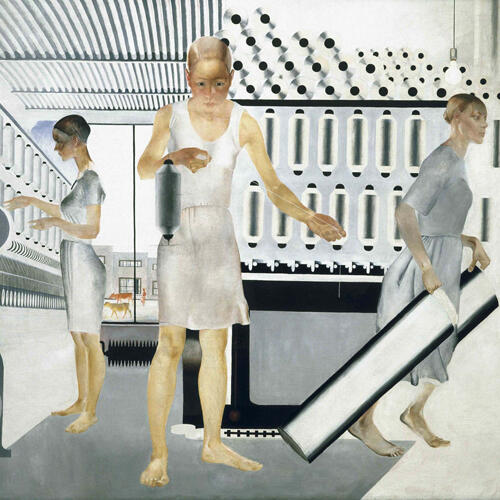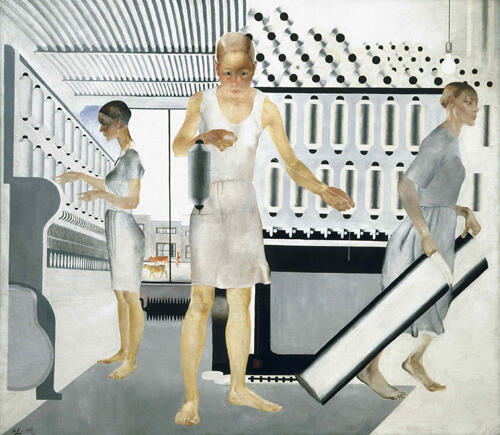Aleksandr Deineka retrospective at Juan March Foundation
Stalinism, associated with the darkest years of Soviet rule, which no doubt was, is a well-known historical period in its social, political, economic and even cultural. But the art of this period, related to the so-called "socialist realism", the current method for all Soviet artists since 1932, is not sufficiently known in terms of its principles and the relationship with the avant-garde movements that preceded or with the realism that developed in parallel in other countries during the thirties of last century.

Often, the art of the Stalin era raises a negative moral judgment: the service of the same totalitarian political power responsible for the settlement (in some cases, literally) of the vanguard, Socialist Realism that happened in the USSR from last century twenties and thirties. In this context, retrospective Aleksandr Deineka (1899-1969) a vanguard of the proletariat, first introduced in Spain, with 80 works by the artist, not only is the largest outside Russia exhibition dedicated to the figure of Deineka, but rather to present it in the dual context to which it belongs: the end of the vanguard and the advent of socialist realism.
That is a goal for which it is difficult to find a better example than that provided both Deineka pictorial force, as fascinating ambiguity of his art and illustration. Formed in the establishment of avant-garde, was a member of the last groups of the Constructivist avant-garde (as Oktyabr or OST), and agitator committed to the revolution and socialist construction in the country, which did not prevent being accused of formalism, the while obtained permission to travel abroad and received outstanding orders of the Soviet state, whose utopian claims allowed him to get some of the figures and representations achieved.
That kind of "ambiguity" has been used by a careful and extensive selection of works by Russian avant-garde artists and magazines, posters, books, documents and objects on display to present the unique (and unknown) logic of relations between the vanguard and socialist realism, which understood itself, obviously, as a sort of artistic-political vanguard of the proletariat, more radically in sync with the political construction of the Soviet utopia than with his own artistic vanguard. Therefore, the exhibition traces an arc that goes from the future-the first opera Victoria sobre el Sol (Victory over the Sun ) by Kruchionij and Malevich, 1913 - and ends with the death of Stalin in 1953, serving the most diverse manifestations of art that permeated all spheres of life and accompanied attempts to radically transform the reality at the hands of political power was conceived demiurgic himself in artistic terms.
Therefore, in addition to the broad representation of Deineka work, the exhibition includes works-some of them exceptionally significant, avant-garde figures such as Kazimir Malevich, Alexei Kruchionij, Vladimir Tatlin and El Lissitzky, Liubov Popova of Aleksandr Rodchenko, Aleksandra Exter, Gustav Kluzis, Valentina Kulagina, Vladimir Mayakovsky, Nathan Altman, Mechislav Dobrokovski, Solomon Telingater or Aleksei Gan, or other realistic as Petrov-Vodkin Kuzma, Yuri Pimenov, Dmitry Moor or Aleksandr Samojvalov, among others.
The exhibition includes the work of Deineka, from its beginnings in the twenties, until their twilight years works of 50, in which the halo of the future that seem to possess some of his early compositions, takes the hard materiality of grey, so this in everyday life where utopia seemed to have solidified. Combining samples of his work as a graphic designer, his extraordinary collaboration posters and magazines, along with stunning works of monumental form, the exhibition brings together a broad set of pieces of mass-scenes and factory enthusiasts, sportsmen and farmers, the idyllic, dreamy-Soviet life are revealed, as great adventures pictorial formal beauty as formidable metaphors from Soviet utopia, the total revolutionary transformation of social and material reality, by the dialectic of capital and labour.
The total set of works and documents, about 250, mostly from the State Tretyakov Gallery and the Russian State Museum in St. Petersburg, as well as some provincial Russian museums and a number of public and private collections in Spain, Europe and the United States.
-
 Aleksandr Deineka
Aleksandr Deineka
Trabajadoras textiles, 1927
Credits / Créditos: Museo Estatal Ruso, San Petersburgo
Courtesy / Cortesía: Fundación Juan March
-
 Aleksandr Deineka
Aleksandr Deineka
¡Trabajar, construir y no lamentarse!, 1933
Credits / Créditos: Colección Merril C. Berman
Photo / Foto: Jim frank, Joelle Jensen
Courtesy / Cortesía: Fundación Juan March
-
 Aleksandr Deineka
Aleksandr Deineka
Autorretrato, 1948
Credits / Créditos:Pinacoteca Estatal A.A Deineka, Kursk
Courtesy / Cortesía: Fundación Juan March




